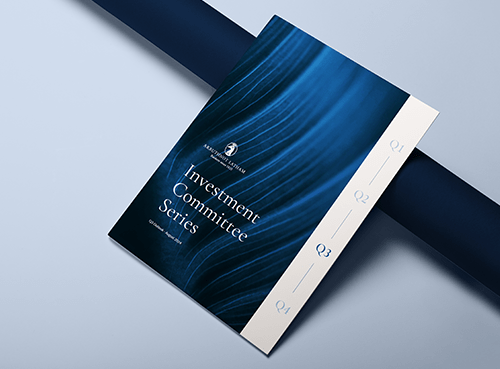

Top of mind -
Changing dynamics in the real estate market
In our latest Top of Mind article, Kieran Staunton, from our Investment Management team, shares expert insights on developments in property and in particular listed real estate.
The real estate market has faced significant turbulence in recent times. Property values have fallen as the post-COVID environment continues to shift demand dynamics, while interest rate increases played a significant part in falling property values. Despite this, many sectors of the property market have demonstrated robust rental growth. With the global interest rate hiking cycle behind us, in this article, we explore the potential opportunities in listed real estate.
Pandemic fallout and interest rate hikes
The property sector has been impacted by two significant events over the last four years. First, the COVID-19 pandemic has fundamentally altered the dynamics of both retail and office real estate markets. The rise of ecommerce and remote working has negatively impacted the demand for these spaces. Second, following the pandemic, central banks worldwide embarked on an aggressive interest rate hiking campaign to combat inflation. Higher interest rates drove down property values. This created a particularly challenging environment for real estate companies, a sector heavily reliant on leverage, which resulted in the stark underperformance of listed Real Estate.
Impact on valuations and income potential
It is important to note that despite the depressed valuations, rental growth in many sectors remained robust. This resilience in rental income has made listed property an increasingly attractive source of income for investors seeking yield in a challenging market environment.
As yields fall, REITs tend to outperform

Source: Bloomberg - July 2024
The impact on net asset values (NAVs) nevertheless, has not been uniform across global markets. A notable divergence has emerged with the US market demonstrating greater resilience compared to the UK and EU. The US real estate market has weathered recent storms better, due to its diverse sector composition and particularly to the higher allocation to data centres and warehouses. The exponential growth in digital transformation and cloud computing has propelled the continued demand for data centre space. Simultaneously, the ecommerce boom after the pandemic increased the demand for logistics, keeping vacancy rates low and allowing rental growth to remain solid. In contrast, the UK and European real estate markets have faced more significant hurdles in their recovery as they are heavily exposed towards traditional sectors such as office and retail properties. These sectors have been challenged by working from home and ecommerce trends. The disparity in performance underscores the critical importance of rental levels. Markets and sectors that have maintained strong rental growth, paired with low vacancy rates, have seen better returns.
Loan-to value ratios and market fundamentals
Despite the impact of higher interest rates on real estate loan books, our research indicates that loan-to-value (LTV) ratios have remained relatively stable across various sectors. This stability suggests that while the rising interest rate environment has certainly posed challenges, it has not led to a widespread deterioration in the financial health of real estate companies and investment trusts. Our analysis revealed that most real estate companies and Real Estate Investment Trusts (REITs) have maintained conservative LTV ratios, providing a buffer against market volatility and potential property value declines.
Historical perspective: REITs and interest rates
Examining historical data reveals a strong relationship between the US 10-year Treasury yield and the performance of REITs. During periods when yields rise, the global stock market (as represented by world indices) tends to outperform Global REITs and vice versa. The significant increase in interest rates since 2022 has been the primary catalyst affecting REIT valuations. Now that the aggressive interest rate hiking cycle is behind us and bond yields are contained, REIT performance has stabilised. Bond yields falling from hereon could be a catalyst for REIT outperformance.
The cyclical nature of REITs and their economic sensitivity
While REITs share certain characteristics with fixed-income securities, particularly their sensitivity to interest rate fluctuations, REITs are also sensitive to economic growth. This cyclicality becomes especially pronounced during periods of economic turbulence and recovery, adding an important dimension to their performance relative to other asset classes. The relationship between REITs and Gross Domestic Product (GDP) is strong. During periods of economic contraction, when GDP growth slows or turns negative, REITs often experience downward pressure on their valuations. In an environment where interest rates are falling or reaching their peak, combined with signs of growing economic activity, REITs are often positioned to outperform equities.
Looking ahead: potential opportunities
Despite the challenges, the current market environment may present an opportunity for REIT outperformance relative to other sectors, with yields falling and growth remaining solid. Depressed valuations in certain sectors may offer attractive entry points for long-term investors. With robust rental growth in some sectors, REITs and other real estate investments can provide competitive income streams. However, capitalising on these opportunities requires more than a passive, broad market approach. The disparities between different sectors and regions underscore the critical importance of active investment management in the current environment.
Investment Committee Series
Our Investment Committee share their key decisions and outlook for Q3 2024 here

Author -

Kieran Staunton, CFA
Investment Manager
Kieran joined Arbuthnot Latham in January 2018. He currently leads the Real Estate and Infrastructure research pods, is a member of the Alternative Investments research team and a voting member of the Sustainable Portfolio Service. Alongside his research responsibilities, Kieran also advises clients on their investments.
Kieran is a CFA Charterholder and also holds a BA in Banking and Finance from the University of Leicester along with a MSc in Investment Management.
A keen golfer having held a handicap of 4 at Luffenham Heath Golf Club, Kieran’s spare time consists of watching football, cricket and rugby, reminiscing of the days his joints allowed him to partake!
DISCLAIMER
This communication should be considered a marketing communication. It has not been prepared in accordance with legal requirements designed to promote the independence of investment research. It is for information purposes only and does not constitute advice, a solicitation, recommendation or an offer to buy or sell any security or other investment or banking product or service. You should seek professional advice before making any investment decision. The value of investments, and the income from them can fall as well as rise, and may be affected by exchange rate fluctuations. Investors could get back less than they invest. Past performance is not a reliable indicator of future results. The tax treatment of investments depends upon individual circumstances and may be subject to change.
The contents of this communication are based on opinions or conditions as at the date of writing and may change without notice. To the extent permitted by law or regulation, no warranty of accuracy or completeness of this information is given and no liability is accepted for its use or reliance on it.